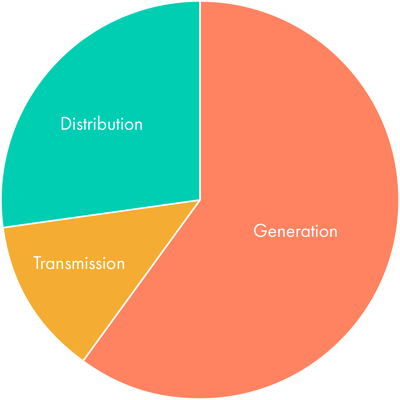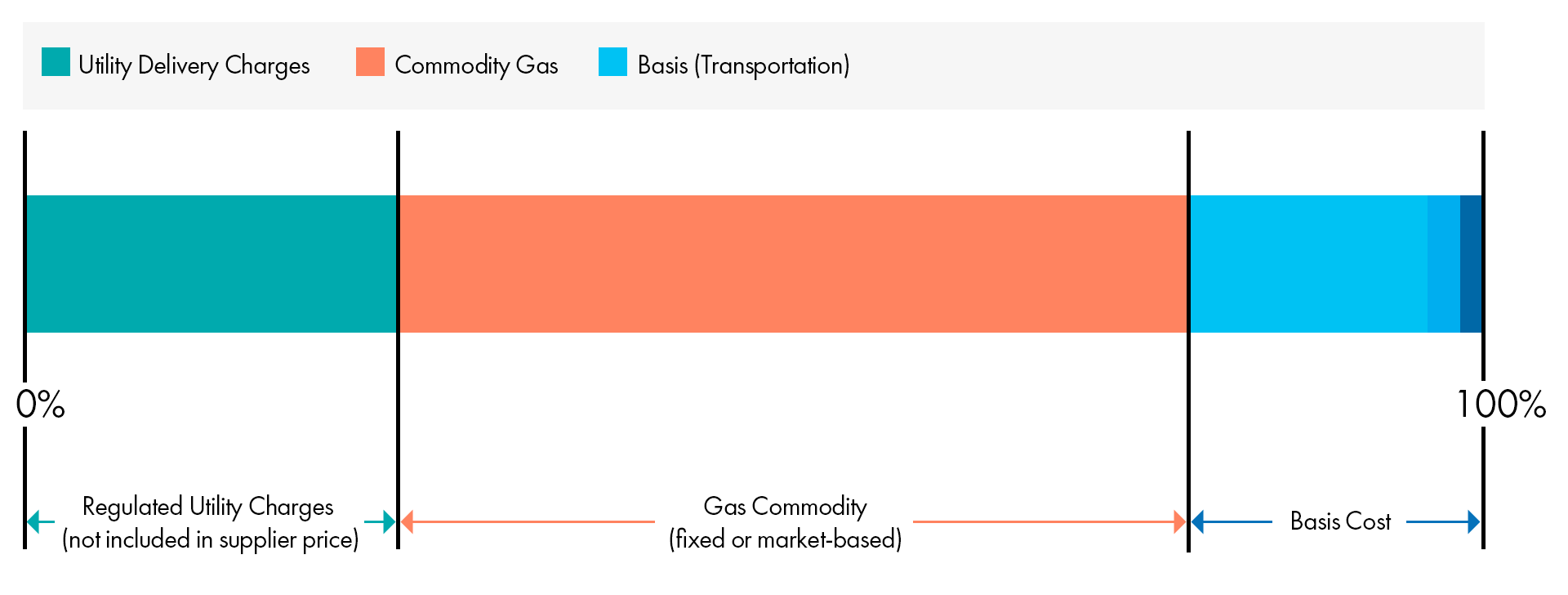Energy Procurement | January 5, 2023
Energy Pricing in Deregulated Markets and Its Inherent Risk
Assessing risk in your energy spend can be complicated but by understanding what makes up your energy pricing—whether electricity or natural gas —and the factors that influence it, is the first step to understanding how you can mitigate long-term risk with your energy procurement strategy.
Electricity Prices
The price you pay for electricity is comprised of the charge from the utility and the flow of power to your home or business.
The utility charge generally reflects the cost to build, finance, maintain, and operate power plants and the electricity grid (the complex system of power transmission and distribution lines), whereas the flow of electricity is the product you are buying.
The diagram below is an illustration of how each component makes up the total cost of electricity. The regulated delivery charges—transmission and distribution—are set by the utility company, whereas the remaining components, the orange slice, make up the cost of generation, which is where your opportunity lies.
Depending on your procurement strategy, some or all these supply components may or may not appear as separate line items. Also, these elements make up all supply prices, whether part of a competitive supply price or the utility’s basic service.

To put it in simple terms, there are some utility costs you can’t control. These include:
Transmission (Delivery)
The “Highway” of electric delivery.
Movement of bulk electricity supply from generation sites over long distances to substations closer to areas of demand for electricity.
Distribution (Delivery)
The “City Street” of electric delivery.
Electricity travels on a distribution system at a voltage level that can be delivered to a home or business.
And now let’s talk about something a little more complex.
On the other hand, within some electricity price components you can have an impact and an energy expert can help you maximize your opportunity therein.
Generation (The power flowing into your house or business)
Generation is the electricity that comes from sources available to you on your local power grid. It is generally comprised of these components, although the percentage of each varies by state and utility (i.e. ISO-NE, PJM, ERCOT, etc.) An energy broker, like Mantis, can help you get the best possible price for these components:
- Energy Commodity – The cost electric generators charge for the power they produce and send onto the grid.
- Capacity – The cost paid to generators to be on standby to meet and balance the demand of the electric grid.
- Network Integrated Transmission Service – A more detailed cost of moving electricity between generator and end user.
The portions of generation over which you have less control, outside of generating your own power on-site include:
- Renewable Portfolio Standards (RPS) – The cost to meet minimum state-mandated renewable energy requirements.
- Ancillary Services – This is a small cost that includes all other costs, and there a lot.
- Line Losses – The cost of the energy lost during travel from the generator to the end user.
Natural Gas Prices
The diagram below shows every component that makes up the total cost of natural gas. The regulated delivery charges are set by your utility company; the remaining components make up the cost of generation, again, known as supply.
Even though these charges may not show up as separate line items on your invoice, you pay these charges whether you are on your basic service through the utility or if you’re buying from a competitive supplier.

Utility Charges
The infrastructure costs to move the natural gas by pipeline from where it is produced or stored to local natural gas distribution utilities and the cost to deliver it to consumers.
Generation (the natural gas that flows to your house or business)
-
Gas Commodity – The cost of the natural gas itself, either as produced natural gas or as natural gas purchased at a market trading hub or under a contract by marketers and utilities. An energy broker, like Mantis, can help you get the best possible price on the commodity.
-
Administrative – These are the fees required to support the competitive supplier, their billing platform, customer service, and the fee that the supplier collects from the client and remits to a broker, such as Mantis, on behalf of the client. An energy broker, like Mantis, can help you leverage your power to keep these costs at a minimum.
-
Basis – The “Basis Cost” is the difference in cost between two geographic locations, usually the difference between the Henry Hub price in Erath, Louisiana, and the City Gate where a client is geographically located.
-
Gas Fuel Losses – Because of transport cost and leaks in the pipeline, you pay a difference in the cost between the source and where you receive it.
What factors affect these energy cost components?
The cost of energy is affected by many factors, both on a microeconomic scale (basic supply and demand) to more convoluted macroeconomic ones.
These factors can apply pressure on both supply and demand in one or more of four ways:
-
Upward pressure on supply – an increase in the future supply of energy
-
Downward pressure on supply – a decrease in the future supply of energy
-
Upward pressure on demand – an increase in the future demand for energy
-
Downward pressure on demand – a decrease in the future demand for energy
More specifically, these factors can include:
Microeconomic Influences
-
State rules for using renewable energy as well as any associated incentive platforms like rebates for solar installation
-
Regional rules for energy governance
-
Tariff rules for which the energy utility must remain compliant
-
The number of pipelines available for transporting fuel
-
How much energy is being generated at any given time
Macroeconomic Influences
-
Global supply and demand for various sources of energy
-
Federal legislation or pressure, including the White House, Department of Energy (DOE), Environmental Protection Agency (EPA), Federal Energy Regulatory Commission (FERC), and the Climate Advisor to the President of the United States
Why it is important to consider an energy consultant or broker
There are a lot of things you can do as a building owner or operator to maximize the opportunities within your energy contracts for both electricity and natural gas but, as noted above, there are also a lot of factors at play locally and globally. These considerations are all difficult to weigh. A professional energy consultant can help your peer into the future and strategize to ensure you’re taking on an amount of risk that’s manageable for your organization.
In the final blog in this series, we’ll explore Demand Response and how you can leverage it to directly impact your energy spend.
Related Posts
Discover more content and insights from Mantis Innovation

Meeting the Demand: The Impact of Data Centers on Energy Infrastructure
The Explosion of Data Centers Data centers have been a major topic of discussion in the energy industry for several years due to their high energy consumption. With aggressive expansion expected in

The Cost of Inaction: Why Businesses Should Act Now on Energy Efficiency
In today's fast-paced business environment, the financial and operational losses businesses incur by delaying energy efficiency improvements, the "cost of inaction," is more relevant than ever.

In today’s AI era, human intelligence is the key to data center facility and energy optimization
Nowhere else in modern industry do artificial and human intelligence converge with such transformative potential as in the world of data centers. As AI's extraordinary growth accelerates demand for

Your Guide to LED Lighting for Business and Commercial Buildings
Never to be underestimated, LED lighting and well-designed lighting retrofits and upgrades offer businesses big improvements like reduced energy costs, reduced emissions, and improved working